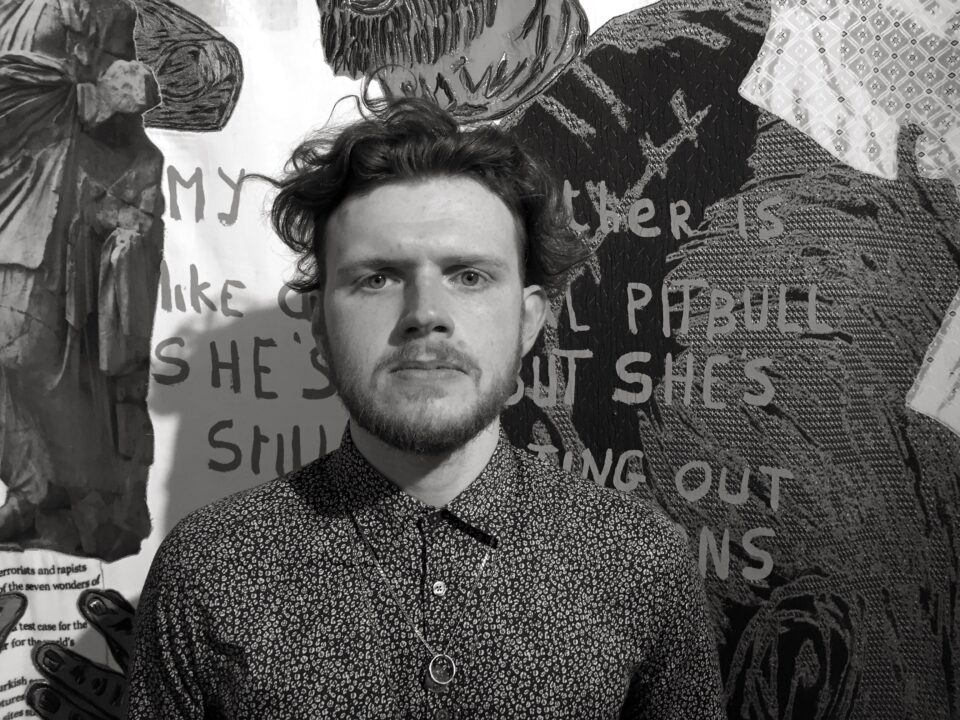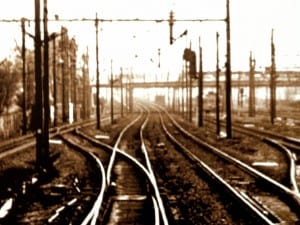Henry Hussey creates artworks informed by significant moments in his life, choosing to juxtapose digital processes and a variety of fabric techniques such as embroidery, dyeing and screen-printing. We catch up with the artist about his methods, inspiration and innovative aesthetic decisions.
A: Your pieces are centred around tangibility; in contrast to the emergence of so many digital mediums, how do textiles resonate with you in creating responses to the world around us?
HH: I find it difficult to connect with digital mediums as they lack a sense of weight that leaves me indifferent to the messages they are conveying. The astronomic rise of technology is drastically changing the way in which we communicate and the impacts of this on art are deeply disconcerting. Mankind has a habit of forgetting that we are animals and having a tangible relationship with materials is essential in keeping us grounded in the world. I do not have this same affinity with digital mediums as the screen acts as a buffer between the viewer and me so I am unable to communicate the message directly.
Textiles resonates with anyone from all walks of life as we have an instinctive relationship to cloth. As a medium it is incredibly powerful at delivering a statement. The physical process of taking hold of materials and manipulating them with my hands is integral to the work and forging the visions that reside within me. The human body is such a captivating instrument as through our sheer physicality we are able to demonstrate and express such a plethora of emotions. The sense of shaping my destiny and taking control it through my actions is ingrained into me and is what drives my ambition moving forward.
A: Embroidery is a very meditative processes; is there a sense that in creating fabric patterns through repetition there is intrinsically a distinctly human state of mind weaved into the works?
HH: Due to the size and nature of my work the meditative process does not necessarily come from the embroidery yet occurs during the composing and making of the piece. By working on a large-scale it gives me an extensive length of time to develop the initial thoughts that inspired the works and enrich them over this period. There is a sense of discovery as the more I explore a work during the making of it, the more I gain a deeper understanding of the piece and insight of what it will become. Textiles are a medium that lacks immediacy yet ultimately rewards those who commit themselves to realising an ideal and fully investing in their intentions.
The process begins a long time before anything reaches textiles as I start each project with a performance piece in order to establish my foundation. Through these performances with actors the inspiration emerges and then begins to gestate and grow over time to form the concepts at the core of my works.
With each work you are seeing a rendition of both a real-life performance and a memory so naturally over time this has changed and become mythologized. Embroidery is a fitting analogy for how I work as I take these stories and tales then embellish them with my perspective and shape them to my will.
A: The colours you use are incredibly vivid, almost obtrusive, is there a particular conceptual intention for this other than the images being aesthetically striking?
HH: The intention of the use of colour in my work is to act as a visual sledgehammer and stop anyone from passing the works without taking note. Textiles are an inanimate medium so I am unable to engage with a viewer in sound or recording so by using explosive chromatics I aim to force a reaction and entice the viewer into the work.
As I have grown in confidence I utilise more flamboyant and emblazoned palettes so that no matter in which context you see the work it will govern the surroundings. When making pieces I try to view them from afar to make sure that both the imagery and colors work in synergy to form an arresting visual.
Studying textiles I learnt how to dye my own fabrics, so all the colours you see in my work are hand-dyed allowing complete control of the tonal range within the work. An advantage I have found through dyeing fabrics is that you are able to harmonize different shades so they accentuate each other because they come from the same source. The reaction to certain colours is dictated by society and context it is seen in, they all have different connotations which wildly vary across populations. I have consciously played with sexuality when it comes to using vibrant pinks and garish tones then combing these with dominating and masculine imagery.
A: Contrast is something that always seems to centre in the composition of your artworks – whether it be the medium itself with digital processes working alongside hand-made textiles, opposing colours, or jarring emotions – how far is it important for you to create something which refuses to be politely harmonious?
HH: The experiences I draw upon in my work are the pivotal moments in my life whether they are the savage conflicts or mournful embraces these situations have come to define me. There is a dichotomy running through my work as I have a tendency to immediately focus on the extremes in each situation then delve into nuances that lay within these chasms. I find it difficult to engage with emotions or ideas that have no personal resonance with me as I cannot invest myself into the narrative or care deeply enough on the outcome. It is never my intention to bear the weight of my emotions on others. It is for the viewer to decide whether they find a connection with what I have portrayed.
The contentious relationship in my works between materials, textures and colours is in order to ensure the works do not remain static, and have a palpable pulse running through them. The juxtaposition of imagery emphasizes the drastic pendulum swings of emotion we experience and our endeavour to uphold our morality.
Equally using palettes that oppose each other installs a sense of unrest and never being able to stand with complete certainty within the composition. On retrospect I work in a counter-intuitive manner, as I am concerned with intimate matters yet instinctively gravitate towards a working on a monumental scale.
A: Could you talk about the processes behind your intensely evocative oeuvre; how do you start constructing a piece, and do you prefer manual or digital methods?
HH: From the inception of a work I move freely between manual and digital methods as I initially start by editing imagery to find the emotional anchoring points. No matter the size or scale of a work I begin each piece with a small sketch then translate this Photoshop to figure out the composition and the practicalities. The process of manipulating the imagery digitally is hugely liberating, as I am able to warp and shape this to fit my needs allowing me to immediately build magnitude into my work. This combination of manual and digital processes means that there is a dialogue within the work, which elevates each component and gives it prominence.
Embroidery is undeniably transformative and I have been shocked at how an element within the work has drastically changed the composition causing me to react and embrace this. There would be no challenge or sense of accomplishment if every work looked exactly as I had envisioned it and I flourish when given obstacles to overcome. Each work embodies a place and time so no matter whether it had intended to purely focus on certain themes as due to real world events it is crucial for this to permeate the pieces. Textiles are a magnificent medium and they give heft and purpose to what am I expressing, as each action I make requires a significant amount of time and effort so it must be done with conviction.
A: What should we expect from you in terms of future endeavours?
HH: In my immediate future I am exhibiting an installation of large-scale works at Art Central in Hong Kong with the gallery Coates and Scarry. This installation concludes a body of work focusing on anger and rewriting the past and I am incredibly fortunate to be able to present it on this platform. Then this summer I have a solo show with Coates and Scarry in July where I will be exhibiting a series of new works chronicling the past two years in my life. At the heart of this will be works that I have developed through performing with the actress Maxine Peake which bring together themes of grief, loss and unrest.
In the studio I have been consumed with how to communicate remembrance and exploring what death does to the memory of a person. How their actions in life become shattered and distorted then reformed in our minds, as we are the ones ultimately that carries them forward and determine how they are perceived. Running parallel to this I have been investigating more socially and politically active work as we are living in a turbulent period with near deafening media coverage. It is difficult not to respond to this deluge of content. It is imperative to respond to these events and the courage to have your voice heard instead of remaining silent.
Henry Hussey’s work will be exhibited at Art Central Hong Kong from 23 – 26 March, Central Harbourfront Hong Kong. www.coatesandscarry.com
Credits:
1. Henry Hussey, courtesy of the artist.





